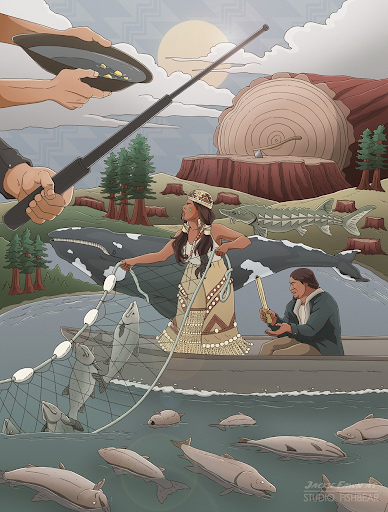Overview
California Law Impact to Native Peoples

Author:
Lynelle Sigona (Amah Mutsun) Education Specialist
Maggie Peters (Yurok/Karuk) NASMC Learning Specialists Humboldt County Office of Education
Grades: 11
Suggested Amount of Time: Three 55 minute sessions
Curriculum Themes
- History
- Law/Government
- Cross Curricular Integration
Learning Goals
Evaluate early California lawmakers and settlers’ relationships with Indigenous groups established since time immemorial
Consider how colonization of California has lasting and ongoing impacts to the health and opportunities of Native populations.
Lesson Overview
This unit offers students a powerful and honest exploration of California’s early statehood through the lens of Native history, ethics, and civic responsibility. Instead of glorifying westward expansion or the Gold Rush, students investigate the devastating impacts of colonization, state-sanctioned violence, and the legal infrastructure that enabled the genocide and enslavement of Native Californians. Through engaging activities like simulated journalist interviews, primary source analysis (including videos), law critiques, and reflective writing, students deepen their understanding of justice, historical truth, and ethical governance. They are encouraged to question traditional narratives and examine how white supremacy shaped California’s earliest laws and leadership. The culminating task, imagining a more ethical approach to colonization, empowers students to creatively apply their learning, while also identifying real ways to support Native communities today. This unit is not only rooted in critical thinking and empathy, but also fosters meaningful dialogue about history, power, and civic responsibility. It's a timely and impactful resource for any teacher committed to teaching truthfully and equitably.
Teacher Background
Teaching the true history of California’s founding, particularly the violence and systemic oppression faced by Native peoples, requires a careful balance of honesty, compassion, and integrity. For generations, Californians have been taught a sanitized version of history that omits or minimizes the state-sponsored genocide, legal enslavement, and forced displacement of Indigenous communities. When we introduce these difficult truths, we are not only correcting historical inaccuracies, we are offering students an opportunity to understand injustice, develop empathy, and begin to heal from a legacy of misinformation.
It is essential to approach this content with a commitment to truth-telling. The violence against Native Californians was not accidental as it was codified in laws and carried out with government support. Avoiding euphemisms and naming white supremacy, settler colonialism, and systemic racism clearly helps students understand the root causes of this violence. At the same time, we must center Native voices and perspectives by incorporating resources created by tribal communities and Native scholars. These voices provide insight, resilience, and lived experience that textbooks often exclude.
Because of the emotional weight of this history, educators must create a classroom environment that is trauma-informed and emotionally supportive. Students may experience strong feelings, such as anger, sadness, grief, confusion, even betrayal, especially if they are encountering this information for the first time. It’s important to validate those emotions and offer space for reflection, whether through journaling, discussion, or creative expression. Native and other students from historically excluded/systematically oppressed/communities impacted by injustice may feel these lessons deeply. Be prepared to check in with them individually, offer alternative ways to participate, and never place them in the position of having to speak for their community.
Creating a safe and inclusive classroom requires setting norms based on empathy. Establishing community agreements around respect, listening, and curiosity can help support dialogue without placing blame or guilt. Restorative questions such as, “Who was impacted?” or “What can we learn from this?” help frame conversations around understanding and accountability, rather than defensiveness.
Finally, students need opportunities for hope and action. Many will leave these lessons asking, “What now?” Provide pathways for students to engage in healing and advocacy in activities such as developing relationships/engagement with local tribes, supporting Native-led organizations, or designing ethical alternatives to historical injustice. Encouraging students to imagine what ethical colonization could have looked like, or to envision justice-centered solutions today, empowers them to turn difficult knowledge into meaningful change.
Teaching hard history with integrity, compassion, and cultural awareness is transformative. It helps students see Tribal Nations as future partners in shared land tenure, economic development and community members. This lesson helps students grow as thinkers and ethical people capable of shaping a more just future.